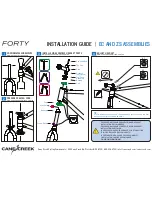
Page 9
HERZ ETKF
Adhesive strip method
• This does not damage the door or window in any way.
• Use the adhesive strips supplied.
• Stick the strips on the rear sides of the brackets (1 and 2).
• Then press the brackets onto the frame and window.
Screw method
• If you are working with a hard surface, you should drill the holes marked (a) using a 1.5 mm drill.
• Use the countersunk head screws supplied to fasten the electronic unit (2).
• Once fastened, the magnet (3) can be inserted in the magnet bracket (1). Then place the cap on the
magnet.
Using screws will damage the frame and/or window. For those living in rented accommodation, this could lead to a landlord
making a claim for compensation or holding back a tenant’s deposit.
Inserting (replacing) batteries
The window contact is operated with 2 micro (LR03/AAA) batteries.
•
Push the release clip (1) backwards.
•
Pull the upper part of the device up and at an angle (2), and remove it from the bracket.
•
Insert 2 new micro batteries (LR03/ AAA) in the battery compartment (3) of the upper part (making
sure they are the right way round).
•
Place the upper part back onto the bracket, allowing it to latch into place.
The service life of new alkaline batteries is approximately 5 years, based on opening the window twice a day for two hours
at a time. If the LED flashes three times when the window is opened or closed, this indicates that the batteries need to be
replaced.
Never recharge standard batteries. Doing so will present a risk of explosion.
Do not throw the batteries into a fire.
Do not short-circuit batteries.
Used batteries should not be disposed of with regular domestic waste. Instead, they should be taken to
your local battery disposal point.
Teaching-in to radio components
To enable radio components to communicate with one another, they need to be taught-in to one another. The window
contact can be taught-in to system components such as a radio energy-saving controller for radiators.
•
The first step is to switch the receiver to teach-in mode. For information on how to do this, please refer to the
operating manual for the relevant device.
•
Following this, the window contact needs to transmit a signal for teaching-in purposes. To initiate this, open or close
the window.
•
If the window contact has not yet been installed, you can simply separate the magnet and electronic unit or rest them
against one another. However, please note that the batteries must already have been inserted in order to do this.
•
When a signal is transmitted, the window contact LED lights up.
A window contact can be taught-in to any number of actuators.
LED flashing sequences & transmission behaviour
The LED’s flashing sequences have different meanings:
Flashing
sequence
Meaning
1x flash
Contact/window closed
2x flashes
Contact/window open
3x flashes
Replace batteries
If, whilst a signal is being transmitted (after the window has been opened or closed), the window contact detects that the
battery power is too low, the LED will emit the “replace batteries” flashing sequence once the signal has finished transmit-
ting.
After a window has opened or closed, the window contact transmits a signal for 5 seconds. Any further changes that are at-
tempted while the signal is being transmitted will not provoke a response. However, if the position has been changed during
this time, the new status will be transmitted directly afterwards and indicated by an LED flashing sequence.
a
2
a
1
3
2





























